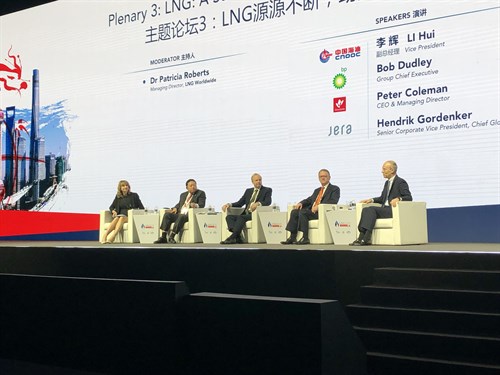LNG2019: LNG proving to be a sustainable fuel for a sustainable future
SHANGHAI—LNG2019 concluded this week in Shanghai, China. A major focus of the event was the industry's challenge of answering the increasing demand for reliable and cleaner sources of energy, with the primary question being: How does the industry adapt to this changing landscape? Sustainability was a consistent theme throughout the plenary sessions, speeches and discussions.
 |
|
The LNG sustainability forum was moderated by Dr. Patricia Roberts, Managing Director for LNG Worldwide, and featured (left to right) Li Hui, VP for China National Offshore Oil Corp. (CNOOC); Bob Dudley, Group Chief Executive for BP; Peter Coleman, CEO and Managing Director for Woodside; and Hendrik Gordenker, Senior Corporate VP for Jera. |
More than 240 speakers and expert panelists presented thoughts and technologies on key subjects that included: a digital and sustainable future; the changing map of LNG supply; the challenges and opportunities of the new LNG landscape; drivers for demand creation around the world; business models for a competitive LNG market; floating LNG; technical innovations for the future of LNG; linking the value chain and enabling financial investment; case studies and trends in LNG infrastructure projects and design; opportunities in China's LNG market; and the diversity of LNG plant capacity.
Program highlight
One of the key panel discussions, "LNG: A sustainable fuel for a sustainable future," featured an impressive group of industry experts. The panel was moderated by Dr. Patricia Roberts, Managing Director for LNG Worldwide, and included Li Hui, VP for China National Offshore Oil Corp. (CNOOC); Bob Dudley, Group Chief Executive for BP; Peter Coleman, CEO and Managing Director for Woodside; and Hendrik Gordenker, Senior Corporate VP for Jera. The panelists focused their thoughts on the industry's future, emissions reductions and renewables use, as well as the opportunities for international and industry cooperation to achieve those goals.
"There should be a focused effort on the complementary roles of renewables and natural gas," said Gordenker. "I don't think the industry has gone far enough to determine how to make that match. There are challenges: people want natural gas to serve as a backup for renewables. On the other hand, the most thermally efficient power plants don't necessarily have the greatest adaptability or ability to ramp up quickly to respond to those needs. There is a lot of work to do to get that message out there [to the public/industry]. It has become clear that the combination of natural gas, LNG and renewables has become an important pathway to sustainability, increased energy access and cleaner air."
One of the most telling questions that Dr. Roberts posed to the group was whether companies were putting enough effort into collaboration, rather than remaining in traditional siloes to invent answers to the industry's challenges. "How can we improve on becoming company- and industry-wide advocates?" she asked.
"We don't often play well together, because [as an industry] we tend to do things because we have to and not because we should," said Coleman. "It takes a lot of effort, and it takes a lot of trust. Often, that trust is not rewarded as people start to move away from the original intent. Generally, cooperation comes when there is a need and few alternatives." This statement elicited agreement from the panel and capacity audience.
"However, as an industry we can do it," Coleman continued. "With reducing the industry's emissions footprint, a lot of us are doing very interesting things, and we could all do more to share those methodologies and technologies in that space. As the world changes, I think we need to try again on some of the things that might have failed in the past."
BP's Dudley echoed these sentiments, saying, "The common ground is that no one company is going to solve these challenges, or competitively distinguish themselves with the size and scale of our industry. The Oil and Gas Climate Initiative (OGCI) was formed to cooperate on these issues, and the member companies, IOCs and NOCs represent 30% of global oil and gas production. What can we do with all the technologies being developed? We worked to focus it down to some key points that include the role of methane and ethane emissions; a $1-B fund to research and detect efficiency opportunities; giving young startup companies the chance to bring their technologies into our industry; and focusing on policies. We are seeing that this industry cooperation in moving forward in unprecedented ways."
"We need to share resources and create partnerships," commented CNOOC's Li Hui. "We are setting up joint ventures and new corporations to work together on infrastructure projects, and we are seeing great strides in this area. The advancement of the industry depends on societal and governmental support, as well, including regulations and technological standards. This is the joint duty of our industry."
Looking forward
As the week-long event ended, the focus turned toward LNG2022, which will be held in Saint Petersburg, Russia. The organizing committee made it clear that it will be interesting to see how the ideas shared this week will come to fruition, and they look forward to further collaboration and cooperation.
Sergey A. Kalityuk, Director General of the National Organizing Committee for LNG2022, said that his group is already working hard and committed to prolonging the traditions of the world's largest LNG exhibition and conference. "Our goal is to make the event in Saint Petersburg interesting, convenient and useful for all attendees," he said.

- ExxonMobil halts 1-Bft3d blue hydrogen project in Texas
- Aramco and Yokogawa commission multiple autonomous control AI agents at Fadhili gas plant
- Ukraine will resume gas imports via Transbalkan route in November
- Mitsubishi to inject $260 MM into Brunei LNG project
- Freeport LNG (U.S.) on track to take in more natgas on Thursday after unit outage



Comments